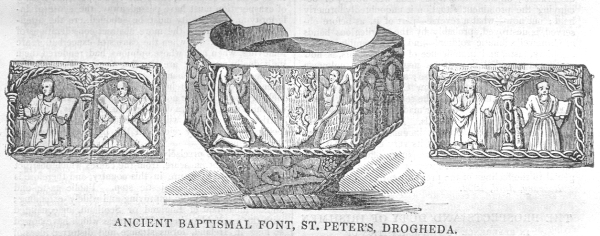ANCIENT BAPTISMAL FONT, ST. PETER'S, DROGHEDA.
From the Dublin Penny Journal, Volume 1, Number 45, May 4, 1833

The font, of which the above is a representation, formerly occupied a conspicuous place in the Collegiate Church of Saint Peter's at Drogheda--a building which, although long destroyed, in former days yielded to none in this kingdom in extent or magnificence--its precincts contained several chapels and oratories, erected and dedicated by the piety of individuals renowned in their day. At various times, within its walls, were held Synods for the regulation of the spiritual concerns of Ireland, over which, the venerable Primates of Armagh presided--and beneath its floor, reposed the ashes of those who, in this life, ruled and swayed the destinies of thousands.
We have strong evidence to prove this church was rich in ornament and decoration; and that the various arts then in use for the enrichment of ecclesiastcal edifices were put in requisition for its embellishment. In "Guillim's Display of Heraldry," page 327, (printed A.D. 1000) the following- example occurs :--"He beareth argent, a cheuron engrailed between three trumpets sable, by the name of Thunder; this coat armour standeth in a glass window, in St. Peter's Church, in Drogheda, in Ireland," and we have record in Harris's Collections, vol. 2d, as quoted by Archdall , that "the steeple of this church, supposed to be the highest then in the world, was thrown down by a violent tempest, about midnight of the 27th Jan. 1548." This steeple was subsequently replaced by one of wood, which continued until 1649, when Cromwell, like a destroying angel, swept the land with the besom of destruction;--after forcing an entrance into this devoted town, he caused this "church to be fired," and in it he acknowledges "above 2000 persons were put to the sword, flying thither for safety. See the 36th number of the Journal. The ancient church of St. Peter's never recovered this visitation; that it was partially repaired, is evident from a view of the town, engraved in 1692, in possession of the writer, in which it is represented as having a steeple; but in the year 1740, it was entirely removed and the present beautiful edifice, of Grecian architecture, erected on its site.
Among the ornaments in the original church, the subject of this notice must have been conspicuous: it presents a very beautiful specimen of ancient art; and being composed of lime-stone, the produce of the neighbouring quarries, is evidently the work of a native artist.
In form, it is an octagon--a figure usually employed by the ancient Christian Irish in the construction of baptistories; examples of which we have at Mellifont Abbey, County of Louth, St. Doulagh's, County of Dublin, &c.-- The entire outer surface is elaborately carved; the front facet, contains an escutcheon, empaled baron and femme, supported by two angels in a kneeling posture, the bodies and limbs of which are represented as covered with plumage; three of the compartments are destroyed, but probably correspond with three of those that remain, which are each divided into two circular-headed niches deeply recessed; each niche containing the figure of an apostle, distinguished by his peculiar badge: thus, St. Andrew with his cross; St. Paul with a sword, and so on; the remaining division is occupied by a representation of the baptism of Christ. The soffetts are each filled by the figure of a demi angel, with wings displayed, supporting a plain scroll; in the corners of the soffetts are the rose and shamrock; the angles of the entire font are ornamented by a continuous wreathing or chain work, which is also continued round, and forms the outline of the arched niches. There are neither dates or inscriptions; and the base is finished by a roped member.
The arms in the escutcheon are, first--Azure, a bend voided argent in chief, a star of the second; secondly-- Argent, three lions rampant azure; the latter coat is that belonging to the name of Mildmay, it also appertains, with a change of tincture, to the family of Fynes, of Fynestown castle, near Navan, County of Meath. Of the first coat I have not been able to find an appropriation, but have discovered it with the bearing reversed (a sign of illegitimacy) empaled with that of Dardis, in St. Peter's church-yard. The carving is in bold relief and skilfully executed; a good deal of tasteful design is manifested in the disposition of the drapery of the first figure in each compartment. The other figures are clothed in close plaited tunics; the sharpness of the engraving is worn off by time and abuse, and the features defaced, but the tonsured head and peaked beard are still discernible; on the whole it has been well worthy of occupying the prominent situation it undoubtedly formerly held; but now--what a reverse--part of it, as before observed, is destroyed, probably by the sacrilegious hands of Cromwell's fanatic soldiers--and this venerable relic of the piety, taste, and munificence of our ancestors, is now consigned to oblivion, and lies neglected and unknown in the yard of the Sexton's house; and this sacred laver, from which so many of our fellow Christians received the initiatory rite of baptism and the seal of our faith, is now shamefully desecrated, by being made a receptacle for the food of the filthiest of animals. Perhaps if this notice meets the eye of the present incumbent, (who, we are conscious, is utterly ignorant of its very existence,) it may induce him or some other active parish officer, to have it removed to a situation more worthy of it, and more congenial to the feelings of the present generation.
Rahenny, April, 1833.
R. ARMSTRONG.
